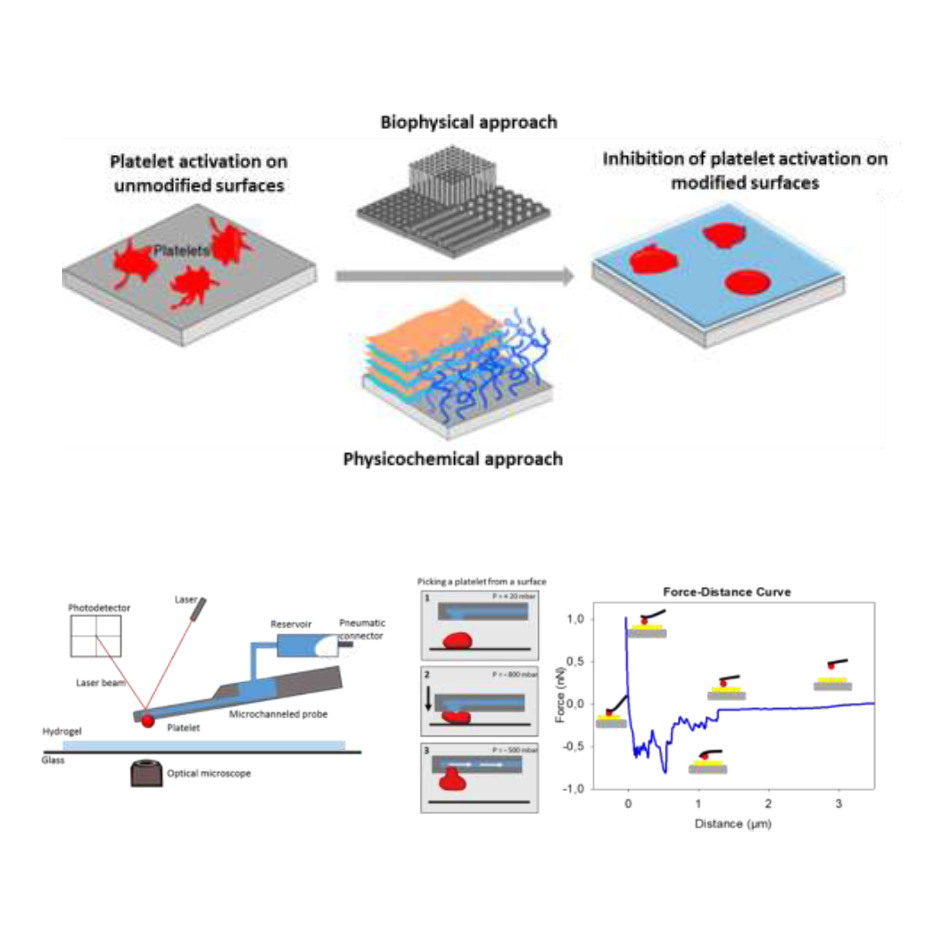
Controlling Surface-Induced Platelet Activation by Modulation of Contacting Interfaces
-
Author:
Gurunath Apte
-
Source:
Dissertation, Karlsruher Institut für Technologie (KIT) (2023)
- Date: 2023
-
Platelets, also known as thrombocytes, are an essential component of the human blood coagulation system. Inside the body, the primary role of platelets is hemostasis. However, platelets have a tendency to activate immediately after brief contact with synthetic, non-physiological surfaces, which can be undesirable for many applications, including platelet storage and research of platelet-drug interactions. Usually, platelet concentrates are stored in commercial plastic bags, which use an excessive amount of plasticizers to increase the flexibility of the bag and avoid any possibility of breakage during its handling and transport. Long term exposure can lead to leaching of the toxic plasticizers into the platelet concentrates.
A plethora of proteins are released by activated platelets, which further assist in the process known as surface-induced platelet activation (SIPA). SIPA is a major concern when dealing with blood-contact medical devices and transfusion apparatus. It is also one of the key factors responsible for the reduced shelf life of stored platelets. To avoid SIPA, anticoagulants are added to the stored platelet concentrates, allowing them to be stored for a maximum of 5 days. These anticoagulants interfere with the activation pathways of the platelets, thereby affecting their functionality. Lastly, the most common problem with platelet storage is the possibility of bacterial contamination. To address the problem, a number of UV treatments are employed to minimize the risk associated with pathogen contamination. However, studies show that exposure to this low wavelength radiation can disrupt the components of the platelet membrane and result in platelet activation. These numerous, oftentimes interconnected problems illustrate the pressing need for an effective solution to optimize platelet storage conditions and maximize their shelf life.
The aim of this work was to engineer surfaces that inhibit platelet adhesion and therefore prevent their activation and aggregation – without the need for anticoagulants. For the modification of surface properties, three different approaches can be employed: Biophysical, physicochemical, or biochemical strategies are availabe to design a platelet friendly surface. In the first phase of this project, a combination of physicochemical and biophysical approaches was applied to prepare hydrogels from gelatin and agarose, which were subsequently fabricated into nanocomposites by integrating iron nanoparticles. Agarose-based hydrogel films are thereby convinced by the combination of favourable surface wettability and mechanical properties. Microscopic images revealed that the number of platelets adhering to such surfaces was significantly reduced and platelet spreading was prevented. The fabricated agarose and its nanocomposites furthermore were found to successfully inhibit bacterial fouling. In addition, the highest percentage of dead bacteria was quantified over the nanocomposite films.
The topography of the substrate plays a crucial role in dictating the cell's behavior and controlling their physiology and morphology. Numerous sophisticated techniques are available to tune the topology of a surface in order to enhance the desired cellular functions. In this work, two techniques with individual advantages were applied to fabricate nanopatterns. The first was an atomic force microscopy (AFM)-based fluidic system called FluidFM, where a liquid-phase monomer based ink is extruded out from a cantilever with an aperture on the tip. Post-printing, the ink is polymerized to obtain 3D structures. Continuous and discontinuous topographies were employed to fabricate hexagonal hive and hemispherical grid structures, respectively, which revealed that the platelets mechanosense these physical cues and reorganize their cytoskeleton, resulting in lower spreading of platelets on the patterned surfaces as compared to the non patterned. Further, the technique was applied to print a modified biofunctional ink customized to integrate molecules with different functional groups into the base ink. This modification caused only a minor change in the mechanical properties of the printed structures while retaining their functionality. The ability to incorporate binding motifs to achieve specific interactions demonstrated FluidFM's versatility, which further paves the way to explore the biochemical/topographical approach in the domain of engineering platelet friendly surfaces. The printing device serves as a fast, cheap, and effective way to produce different geometrical prototypes of nanostructures and can be employed to survey not only distinct shapes but also their size and other topographical parameters.
The second technique used was thermal nanoimprint lithography(T-NIL), where a broader range of surface topologies could be investigated, including dot, chain, pill, and square. These nanopatterns were etched on silicon wafers and transferred to a PDMS-based stamp, which was then used to imprint hydrogels. Agarose gels were used to improve the observed inhibitory effect on platelet adhesion by integrating different topologys on the surface via imprinting The pill-shaped nanopattern demonstrated its superior ability to inihibit platelet adhesion, which can be attributed to the structure's height.
To conclude, in this project, agarose-based hydrogel films, especially in the form of nanocomposites with antibacterial iron nanoparticles, were found to significantly improve platelet storage conditions by reducing SIPA and the risk of bacterial contamination. UV treatments of platelet concentrates are thereby rendered unnecessary. By introducing different surface topologies, platelet adhesion can be inhibited: The FluidFM based multifaceted nanoprinting system was employed to explore and develop prototypes of effective geometries, while T-NIL demonstrated how a distinct patterns can be transferred onto the malleable agarose based gel surfaces to create a uniform surface topographies.
